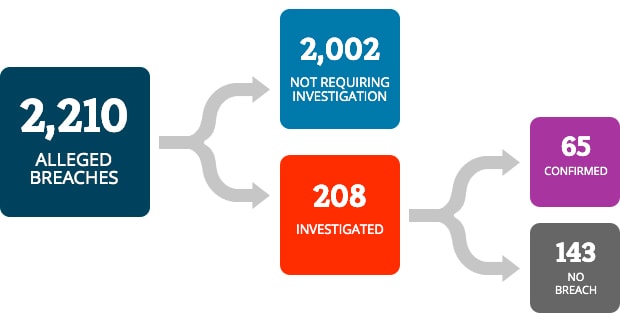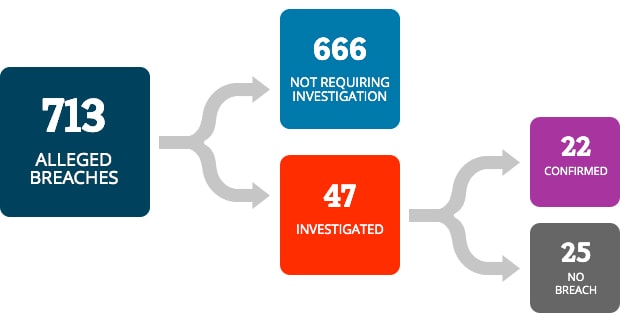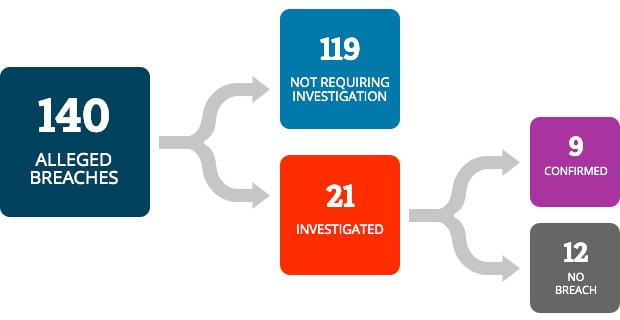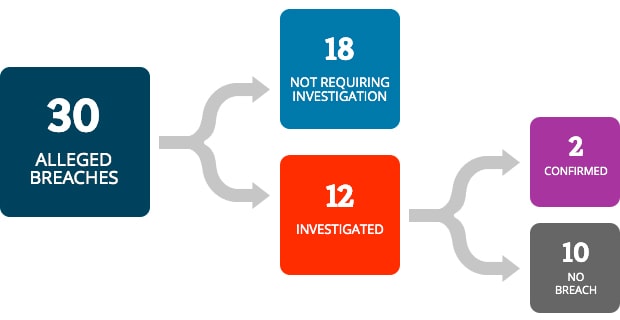When the CCTS investigates customer complaints about telecom and TV services, we try to determine if the service provider has reasonably met its responsibilities to the customer.
Overview of CRTC codes of conduct
We use four mandatory CRTC codes of conduct as yardsticks against which we measure service provider conduct:
- Wireless Code: For consumer and small business (mobile) wireless services.
- Deposit & Disconnection (D&D) Code: For residential home phone services.
- Television Service Provider (TVSP) Code: For residential subscription TV services.
- Internet Code: For all retail fixed internet access services, including cable, fibre, digital subscriber line (DSL), fixed wireless and satellite services provided by Canada’s ten largest internet service providers and their brands and affiliates. Mobile wireless internet services are covered by the Wireless Code.
To learn about how we administer the CRTC codes of conduct, watch the video below.
For more detailed information about the preceding codes, see:
Resolving complaints and analyzing code compliance
When we accept a customer complaint, we record and track all of the issues raised in the complaint. Some complaints raise questions about whether a provider has complied with a code of conduct. We call these “alleged breaches.”
The vast majority of complaints are resolved to the satisfaction of the customer and the provider at an early stage of our process. When complaints are resolved, there is no need for us to investigate the underlying issues, including to determine if there have been any violations of a code of conduct. Therefore, these issues remain characterized as “alleged breaches” and are categorized as “not requiring investigation” in the following figures.
In the cases that we do investigate, we can determine whether there has been a violation. We categorize proven violations as “confirmed breaches.” When we investigate and determine that there has not been a violation, we categorize this as “no breach.”
In this section, we present statistical reports on breaches of the four applicable codes using the preceding terminology.
Wireless Code
The Wireless Code seeks to ensure that consumers of voice and data services are better informed of the rights and obligations contained in their contracts. The Wireless Code applies to individual and small business consumers, and all wireless service providers must follow its guidelines.

There were 65 confirmed breaches of the Wireless Code, a decrease of 32% from last year.
The majority of confirmed breaches relate to disclosure issues stemming from lack of clarity or accurate information in communications with customers, information in and provision of contracts and related documents, and the Critical Information Summary.
This year, there were 8 confirmed breaches of Section A (Clarity), compared to 14 last year. The main issue was wireless service providers failing to communicate with customers clearly.
Confirmed breaches of Section B (Contracts and related documents) and Section C (Critical Information Summary) each decreased by 48% this year, together accounting for 43% of all confirmed breaches. Notably, we confirmed 12 breaches for failure to provide the required key contract terms in the customer’s contract and 14 breaches for failure to provide all the required information in the Critical Information Summary.
Of note, Section I (Disconnection) became the most breached section of the Wireless Code this year, up by 58% this year and accounting for 29% of all confirmed breaches. Notably, there were seven confirmed breaches to Section I.1 (when disconnection is allowed to occur), compared to one confirmed breach last year. A major issue continues to be whether wireless providers are providing sufficient notice of disconnection or providing all of the required information in the disconnection notice, with 12 confirmed breaches for Section I.2.
Freedom Mobile, Koodo, Virgin Plus and Shaw saw an increase in confirmed Wireless Code breaches this year. Freedom Mobile had the largest proportion (19%) of confirmed breaches.
Bell and Rogers saw a significant decrease in confirmed Wireless Code breaches this year. Bell had 6 confirmed breaches this year, compared to 29 last year. It now accounts for 9% of all confirmed Wireless Code breaches, compared to 30% last year. Rogers had 7 confirmed breaches this year, compared to 25 last year. It now accounts for 11% of all confirmed breaches, compared to 26% last year.
Internet Code
The Internet Code was created so that customers of fixed internet access services are better informed of their rights and responsibilities contained in their contracts with internet service providers (ISPs). The Internet Code aims to make it easier for individual customers to understand their internet service contracts, to prevent bill shock from overage fees and price increases, and to make it easier for Canadians to switch internet service providers.
The Internet Code applies only to individual customers; it does not apply to small business customers.
The Internet Code applies only to large facilities-based ISPs and their brands and affiliates. However, when we investigate a complaint about an ISP to which the Internet Code does not apply, we may use the principles of the Code to guide us in determining what is good industry practice.

There were 22 confirmed breaches of the Internet Code this year, up from 18 last year. The top confirmed breach areas were Section B (Contracts and related documents) with eight confirmed breaches (36% of Internet Code breaches), Section A (Clarity) with seven confirmed breaches (32%) and Section I (Disconnection) with five confirmed breaches (23%).
| Large facilities-based ISPs | Brands and affiliates of premium brand |
|---|---|
| Bell Canada |
|
| Cogeco Connexion Inc. (Ontario and Quebec) |
|
| Eastlink |
|
| Northwestel Inc.* |
|
| Rogers |
|
| Sasktel |
|
| Shaw |
|
| TELUS |
|
| Videotron Ltd. |
|
| Xplornet |
|
NOTE: This list is based on the information PSPs provide to the CCTS and this information is subject to change.
* Northwestel’s terrestrial retail internet services are regulated by the CRTC; therefore, customers should forward their complaint to the CRTC. However, Northwestel’s satellite retail Internet services are not regulated by the CRTC, so the CCTS can accept complaints about these services.
TELUS had 11 confirmed breaches and accounts for half of the confirmed breaches to the Internet Code, up from zero last year. Six of these confirmed breaches were for failing to provide required information in contracts and related documents (Section B) and the remaining five were for lack of clarity in its communications with customers (Section A).
Videotron had three confirmed Internet Code breaches compared to zero last year.
Bell had 2 confirmed Internet Code breaches, down from 14 last year.
Rogers, Xplornet and Virgin Plus each had two confirmed breaches of the Internet Code.
Television Service Provider Code
The Television Service Provider Code (TVSP Code) is intended to make it easier for Canadians to understand their television service agreements and to empower residential customers in their relationships with TVSPs.
The TVSP Code applies to only consumers (not small businesses), and all licensed TV service providers must follow its guidelines. We address complaints about subscription TV services provided by cable, Internet Protocol television (IPTV) and national satellite direct-to-home (DTH) TV service providers.

There were nine confirmed breaches to the TVSP Code this year, up from five last year. Three breaches were about Section II (clarity of offers) and another three breaches were about Section IX (information required in the Critical Information Summary). Two breaches were about Section VII (provision of the written agreement and information required in the fixed-term agreement), and one breach was about Section X (changing programming options).
Videotron had four confirmed breaches to the TVSP Code this year, up from two last year and accounting for 44% of all confirmed TVSP code breaches. This year two of these four confirmed breaches for Videotron were about not providing information required in the Critical Information Summary.
TELUS had three confirmed breaches to the TVSP Code this year, compared to none last year and accounting for 33% of all confirmed TVSP code breaches.
Deposit and Disconnection Code
The Deposit and Disconnection Code (D&D Code) provides local phone customers with protection in some cases when they are required to provide a deposit as a condition of obtaining local phone service or when a service provider intends to disconnect the customer’s local phone service.
There were two confirmed breaches to the D&D Code this year, down from five last year. There was one breach for each of Section 3.2 (notice at least 14 days prior to disconnection) and Section 3.3 (advise customer 24 hours prior to disconnection).

The two confirmed breaches to the D&D Code this year were both from Bell, down from three last year for Bell.
